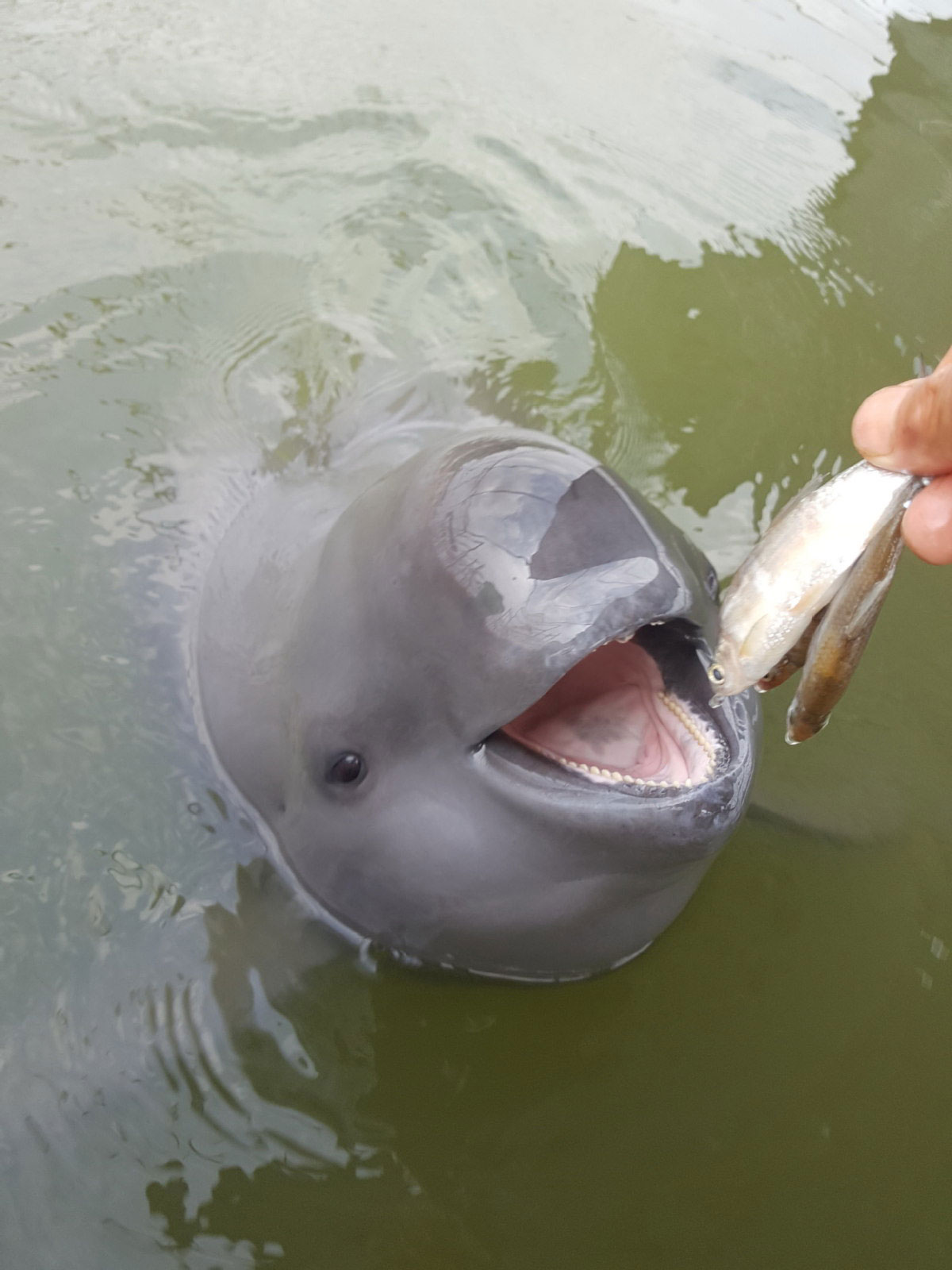

An animal worker feeds Bei Bei with frozen fish in a net cage purpose-built within Tian'ezhou National Nature Reserve in 2018. [Photo/China Daily]
The world's first Yangtze finless porpoise bred in captivity was recently released into the wild, and follow-up tracking will identify whether it can survive, experts revealed.
The 4-year-old female mammal, named Bei Bei, was released last week into the Tian'ezhou National Nature Reserve in Shishou, Hubei province, according to Hao Yujiang, an expert from the Institute of Hydrobiology under Chinese Academy of Sciences.
Bei Bei had been reared in a net cage purpose-built within the reserve. Her parents are two wild Yangtze finless porpoises, one of whom was injured in 2008 by ice in the Tian'ezhou oxbow, an old 21-kilometers course of the Yangtze River, and was rescued by researchers from the reserve.
The Yangtze finless porpoise is one of the very few porpoise species that live in fresh water. Scientific research on the species released by the Ministry of Agricultural and Rural Affairs in 2018 shows that its population was just 1,012-fewer than the giant panda.
In 1990, the institute initiated the conservation of the species outside its natural habitat. Currently, there are more than 80 wild finless porpoises living in the oxbow.
According to Hao, researchers have successfully released two Yangtze finless porpoises that had been rescued. One was a Yangtze finless porpoise name A Bao, who was born in the wild, raised in captivity in the institute for seven years and sent back to the wild in 2011.
"A Bao now has a big family, with 10 grandchildren and at least two great-grandchildren," Hao said.
However, the training for Bei Bei is more challenging as she had no experience in the wild, according to Hao. Before her release, she received about two months of training aimed at helping her adapt.
"Weighing about 60 kilograms, Bei Bei is going to be mature sexually. To release her to the wild now is very important because it will help her to mate successfully," Hao said.
Training therefore plays a crucial role in the process. According to Hao, researchers had helped her get used to the taste of fresh fish and taught her to catch them.
"It was difficult at the very beginning as she was used to the taste of frozen food. Sometimes, she was irritated and flew into a rage," he said.
Moreover, the net cage she used to live in at the reserve was replaced by an open-water area covering 20,000 square meters that was surrounded by nets.
"It will help familiarize her with the water environment in the wild," Hao said.
The Yangtze finless porpoise is found in the main Yangtze River channel in central and eastern China and in two lakes, Dongting and Poyang, which are naturally connected to the river. The porpoise's small size and cute 'smile' make it a much-loved animal in China and beyond.
Over the past 40 years, the porpoise's numbers have declined dramatically due to, among other factors, climate change and habitat loss, according to Zhang Xinqiao, senior program manager of the World Wide Fund for Nature in China.
However, he said the population of the species has shown stability in recent years as a result of joint protection from government organs, research institutes and other social organizations.
According to the institute, researchers from the reserve will monitor Bei Bei and help her if necessary, and data collected on her will be constructive to breeding research and conservation of the species.
"The release was an important step to save this endangered animal. Whether it can be successfully done will provide data and experiences to the artificial breeding of the species, which will further contribute to its protection," Zhang said.
On Monday, Hao said workers in the reserve have noticed an animal, which looks "very like" Bei Bei, at a spot about 1 km from the net cage where she used to live.
The finless porpoise and the Baiji dolphin (Yangtze River dolphin), both members of the cetacea family and the only two mammals in the Yangtze, were designated as "critically endangered" on the red list of threatened species by the International Union for Conservation of Nature in 2013.
However, in 2006 the Baiji dolphin was declared functionally extinct, according to the World Wide Fund for Nature. The destruction of the dolphin's food supply, which was mainly the result of overfishing, was central to its extinction.
The finless porpoise is widely believed to be an important indicator of the ecology of the Yangtze, which stretches over 6,300 km and boasts rich and complex terrains and climates along its basin and has one of the highest levels of biodiversity in the world.
Data showed that there are more than 4,300 kinds of aquatic life living in the Yangtze River Basin, including more than 400 types of fish.
In April, the country released a guideline on improving sewage treatment through the use of price leverage to improve the prevention and control of water pollution in the Yangtze.
To further preserve biodiversity along the river, China also began a 10-year fishing moratorium from the beginning of this year in 332 conservation areas in the Yangtze River Basin, which will be expanded to all the natural waterways of the country's longest river and its major tributaries no later than Jan 1. (China Daily)

86-10-68597521 (day)
86-10-68597289 (night)

52 Sanlihe Rd., Xicheng District,
Beijing, China (100864)

